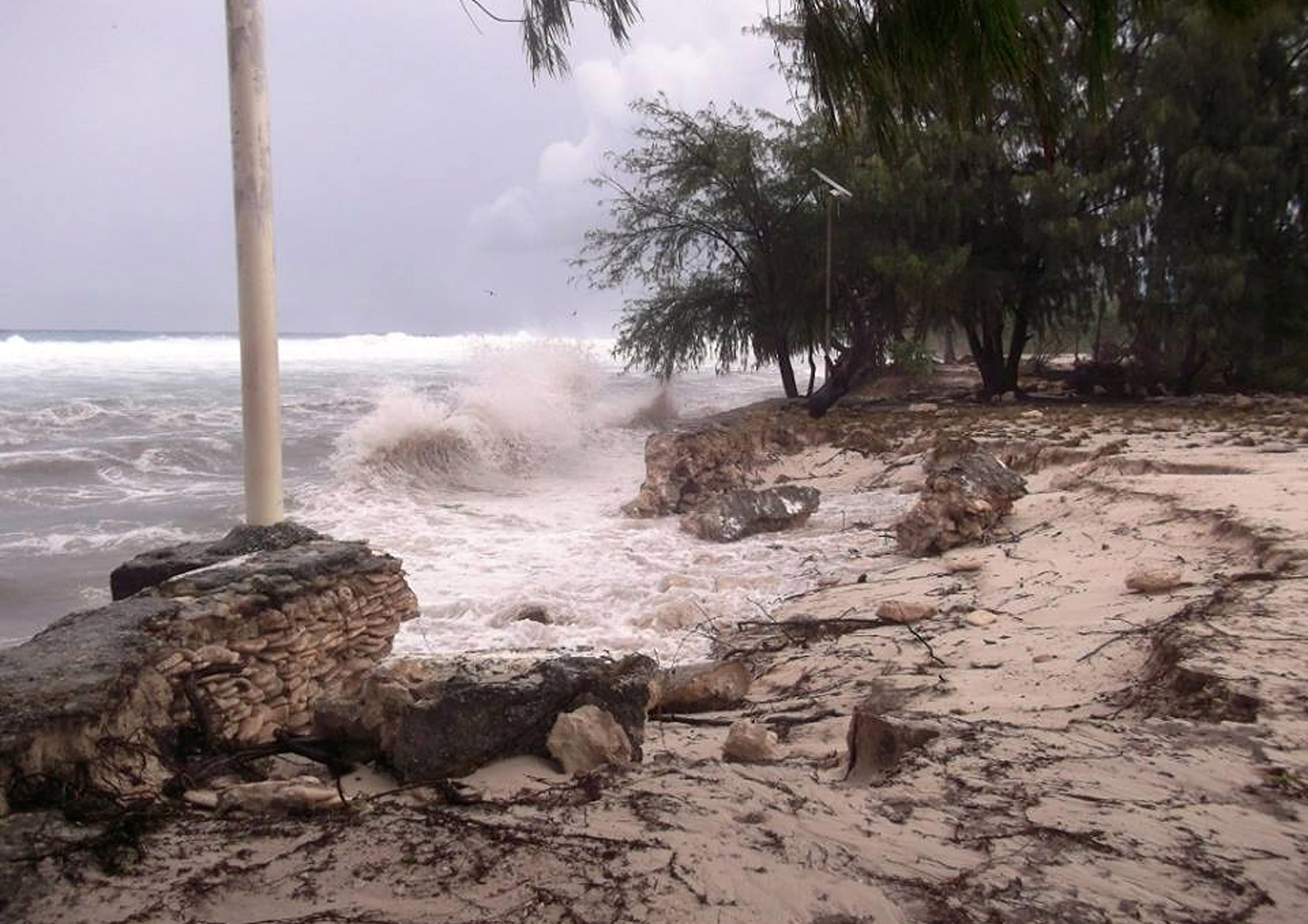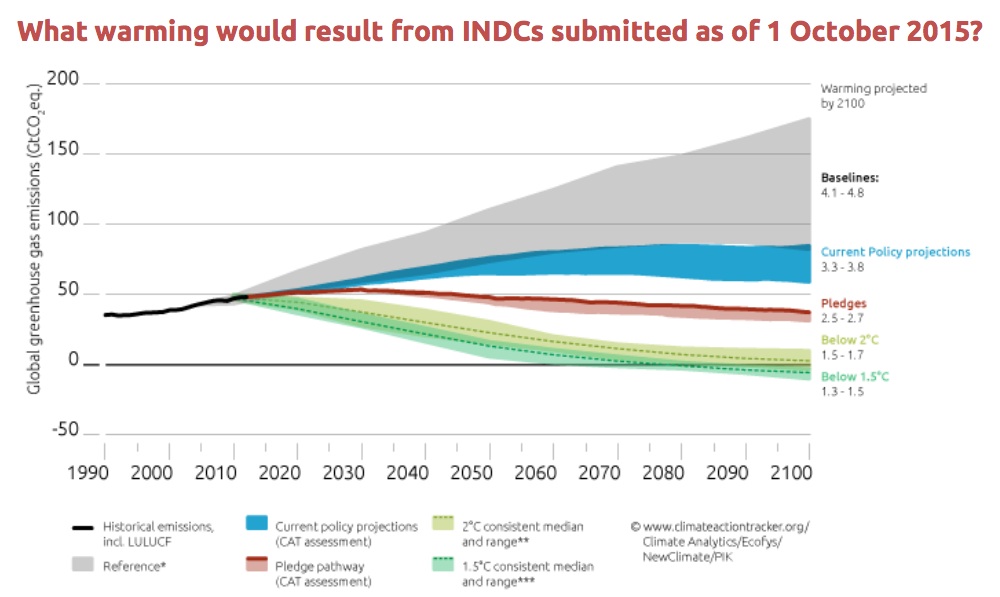ACRONYMS YOU SHOULD KNOW
- COP: Conference of the Parties (i.e. convocation of 195 countries that are working together to combat climate change).
- UNFCCC: The United Nations Framework Convention on Climate Change—an agreement or compact between those 195 countries stating that climate change is a worldwide threat that merits a worldwide response.
- IPCC: The Intergovernmental Panel on Climate Change: a body of scientific arbiters that advises U.N. climate policy initiatives by reporting, verifying, and aggregating research from around the globe. (The IPCC is the organization that shared the Nobel Peace Prize with Al Gore in 2007.)
- INDC: Intended Nationally Determined Contribution, the emissions-reduction targets that each country has submitted (or will submit) to the UNFCCC.
- NAMA: Nationally Appropriate Mitigation Actions (or: emissions targets for poor and developing countries).
- GHGs: Greenhouse gases.
- LDCs: Least-developed countries.

WHAT’S HAPPENING IN PARIS?
What’s happening in Paris is the 21st annual Conference of the Parties (COP) to the United Nations Framework Convention on Climate Change (UNFCCC). The UNFCCC is the framework treaty that emerged from the first Conference of the Parties at Rio de Janeiro in 1992—known then as the United Nations Conference on Environment and Development (UNCED), or more simply as the Earth Summit.
HOW IS THIS CONFERENCE DIFFERENT?
For COP21, 195 countries are sending delegations to Paris with concrete, immediate plans for curbing emissions while adapting to new energy markets and to the environmental changes that are already upon us. The goals this year are clearer and more urgent than before, and there seems to be greater collective political will—thanks, in part, to long-overdue American leadership, the absence of which helped neuter the Kyoto Protocol in the late 1990s and early 2000s. This year’s conference is also huge: Even with heightened security following the terrorist attacks of November 13, Paris is expecting 40,000 official attendees—delegates, lobbyists, activists, journalists—not to mention the tens of thousands observing from outside the conference center’s “Blue Zone.”
WHAT ARE INDIVIDUAL COUNTRIES BRINGING?
Each country will bring its Intended Nationally Determined Contribution (INDC) to Paris. A country’s INDC comprises its goals for emissions over the short-, middle-, and long-term. (You can compare the various countries’ INDCs here.) The most-developed countries are asked to reduce their emissions the most, and to contribute to the Green Climate Fund, which finances mitigation and adaptation strategies in developing countries.
The United States has agreed to reduce greenhouse gas emissions by 25 percent to 28 percent by 2025, compared with 2005 levels. Russia has suggested it would cut emissions to 70 or 75 percent of 1990 levels by 2030—an ambitious cut that the Russian delegation has hedged within a variety of conditional statements. China has also issued a laudably aggressive strategy, but Sino-skeptics are already muttering about double-dealing.

WHAT DO WE DO TO SOLVE GLOBAL WARMING?
If we halt global warming at two degrees Celsius over pre-industrial levels by 2100, climate change might not be utterly cataclysmic. This is a broad global consensus, codified in the UNFCCC since the Copenhagen Accord in 2009. If we allow the Earth to heat more quickly than that, the scientific consensus worldwide—echoed in this U.N. assessment report—is that the glaciers will not shrink but disappear, island nations will start to drown, world agriculture will be wracked with flood and drought, and warming in general will start to accelerate into what are essentially doomsday scenarios.
CAN WE REALLY KEEP THE RISE UNDER TWO DEGREES?
Almost certainly not; to do so, we’d have to approach carbon-neutrality not much later than the middle of this century. Writing last year in Scientific American, climate scientist Michael E. Mann says we’re on track to hit two degrees by 2036, and even the more optimistic projections say the Earth will likely warm by an average of close to three degrees Celsius by 2100.
Climate Action Tracker (CAT) announced last week that “none of the G20 INDCs is in line with holding warming below two degrees Celsius.” Based on the current INDCs, CAT extrapolates a probable (i.e. greater than 66 percent likelihood) rise of no more than three degrees Celsius by 2100—no small discrepancy from the goal of two degrees, but certainly less than Climate Interactive’s projection of 3.5 degrees Celsius by 2100.

SO … WE’RE DOOMED?
Yes and no. Most scientists agree that the two-degree distinction is not so much between “safe” and “dangerous” as between “dangerous” and “catastrophic.” (Some researchers and many activists say the ceiling for long-term human survival is well below two degrees.) At two degrees above pre-industrial levels, the IPCC predicts that wildfires in the U.S. could increase up to eightfold; 20 to 30 percent of animal and plant species will be at an “increasingly high rate of extinction”; and the Arctic will melt almost entirely, helping drown whatever island nations remain. Still: Those long-range forecasts for two degrees are a lot better than what the IPCC projects at four degrees and higher, when we can expect “major extinctions around the globe,” a “reconfiguration of coastlines worldwide,” and further “inundation of low-lying areas.”
In short: Two or three degrees is bad. Four or five is worse.
IS THERE ANY GOOD NEWS?
Yes! Those scenarios above are predictions. It remains possible that we could sustain the human ecosystem—through a phase-out of fossil fuels and aggressive carbon-capture strategies—even if we approach a warming rise of three degrees. Public and private financing toward green initiatives went way up in 2014, and world leaders appear ready to shoulder some sacrifices together. The IPCC has been clearer than ever about the urgency of keeping fossil fuels in the ground, and governments are taking notice. (Carbon-pricing, for the record, is back in vogue.) And the World Resources Institute estimates that clean energy will double if the major powers honor their INDCs. The right advances in tech policy over the next decade could shift those projections above significantly.
And then there is the move toward better adaptation strategies in vulnerable countries—ways these countries can anticipate and indemnify themselves against the tolls of climate change; such strategies include resilient crops, better weather monitoring, and basic infrastructure. One thing we can control, even as the earth starts to sizzle, is how we help our poorest and most vulnerable people prepare for the consequences. Private funding and public support are making this adaptation increasingly possible, and it’s one of the great opportunities for progress at COP21.
WHAT’S THE MOST OPTIMISTIC WAY TO LOOK AT COP21?
We’re taking comfort in these words from Bertrand Gacon, president at Sustainable Finance Geneva: “What humanity is spending on cigarette sales is more than what humanity needs to be spending to solve climate change.”

For updates from Paris starting this Saturday, follow Lucia Graves, Ted Scheinman, and Pacific Standard on Twitter.
“Catastrophic Consequences of Climate Change” is Pacific Standard’s aggressive, year-long investigation into the devastating effects of climate change—and how scholars, legislators, and citizen-activists can help stave off its most dire consequences.





